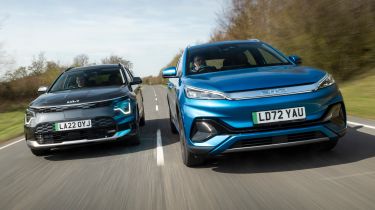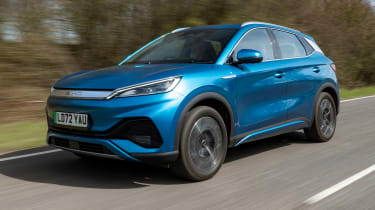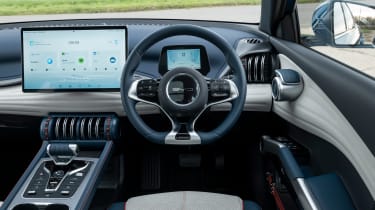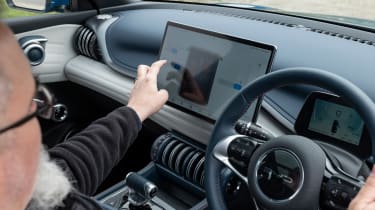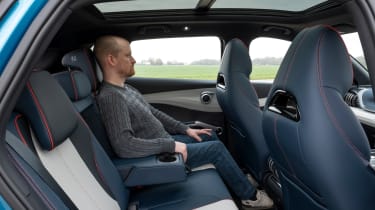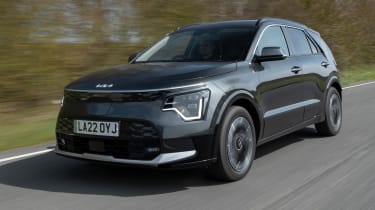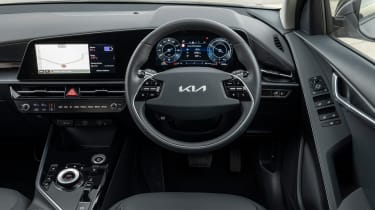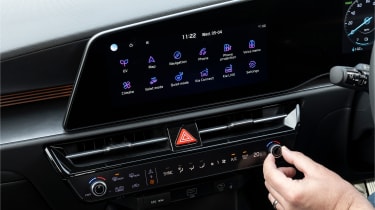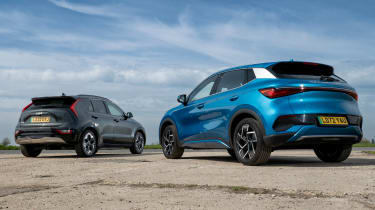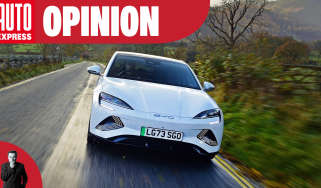BYD Atto 3 vs Kia Niro EV 3: 2023 twin test review
The BYD Atto 3 is the first of a new wave of Chinese EVs - can it beat the already established Kia Niro?
We’re entering a period of major upheaval in the new-car sector, and the move to electrification is an opportunity for a number of Chinese car makers to enter the fray.
One of the first out of the blocks is BYD, an EV manufacturer that has already made an impact in the UK’s bus sector, but is now joining the compact SUV market with the Atto 3. Interestingly, BYD hasn’t jumped into a joint venture for this model; it’s all the firm’s own work. But is it good enough to take on one of the best-established compact EVs on the market, the Kia Niro? It will certainly be a tough test.
| BYD Atto 3 Design | Kia Niro EV 3 | |
| Price: | £38,990 | £ 39,545 |
| Powertrain: | 1x e-motor/60.5kWh lithium-ion battery, 201bhp | 1x e-motor/ 64.8kWh lithium-ion battery, 201bhp |
| 0-62mph: | 7.3 seconds | 7.8 seconds |
| Test efficiency: | 3.5mi/kWh | 3.7mi/kWh |
| Range | 212 miles | 240 miles |
| Annual VED: | £0 | £0 |
BYD Atto 3
While other BYD models such as the Seal and Dolphin have aquatic-themed names, the Atto 3 is said to be named after the smallest measurement of time, the attosecond. The three stands for its supposed attributes of being speedy, energetic and dynamic. Here we’re testing the Atto 3 in top-spec Design trim, which costs £38,990.
Tech highlights
It’s a new name to the UK, but BYD – short for Build Your Dreams – is one of the world’s largest electric vehicle manufacturers. The automotive division of the larger BYD company has been around since 2003, building cars, buses, lorries and even forklift trucks, while the Atto 3 is a second-generation electric model from the firm.
It uses BYD’s latest e-Platform 3.0 electric architecture, which is a dedicated EV base that isn’t shared with any other manufacturers, and has been optimised to boost efficiency. It uses BYD’s own ‘blade’ battery design, which is integrated into the car’s structure to improve its effectiveness.
Used - available now

2022 Toyota
Corolla
35,249 milesAutomaticPetrol1.8L
Cash £15,800
2021 Skoda
Karoq
51,209 milesManualPetrol1.0L
Cash £12,995
2023 Ford
Focus Estate
23,620 milesManualPetrol1.0L
Cash £15,995
2022 Ford
Focus
32,929 milesAutomaticPetrol1.0L
Cash £18,995The Atto 3 has a 60.5kWh battery pack supplying a 201bhp electric motor that drives the front wheels, while the suspension system features MacPherson struts up front and a multi-link rear axle. From the outside, the Atto 3 has a fairly generic soft-roader look that incorporates LED headlights and a full-width LED light bar across the back.
Safety: One thing that has been taken seriously from the outset in an effort to counter any potential preconceptions about poor quality is safety, and the Atto 3 has already achieved a five-star Euro NCAP crash test rating.The Atto 3 matches the Niro EV in most areas, with kit such as blind-spot detection, adaptive cruise with lane and traffic-sign assist, forward- collision alert and rear traffic warning all included.
On the road
There’s plenty of comfort on offer; just don’t push the limits of what the Atto 3 can do.
Around town: At lower speeds, the Atto 3 is very pleasant. The raised ride height and soft suspension mean it copes admirably with rough urban roads, while most of the car’s noise comes from the artificial sound generator that alerts other road users of your presence; it’s not pleasant, though, with a tone that sounds like an open telephone line. This goes silent once you get beyond 20mph, and the Atto 3 feels refined and less fidgety than the Kia Niro at urban speeds. Power delivery off the line is relatively gentle in EV terms, but the Atto 3 is happy to cruise along. There’s no feedback from the steering, though, while the brakes on our test car had a relatively soft pedal when compared with the Niro’s. Most of the time you’ll be using energy recuperation to slow down, although the Atto 3 doesn’t offer one-pedal driving like the Kia.
A & B-roads: Increase your pace and the BYD is still a decent performer, as long as you don’t expect any fireworks when the road gets twisty. The soft suspension that’s in its element around town displays the same traits the faster you go, but this soft edge means the Atto 3 pitches and dives if you’re hard on the accelerator or brakes, although again the latter need a firmer push than the Niro’s set-up. This softness also translates into body roll in corners, and the BYD isn’t as well controlled as the Kia in this regard. Combine this with the lack of feedback from the steering, and the Atto 3 isn’t a car that’s designed with sporty driving in mind.
Motorway: At higher speeds, cruising comfort is fine, although there’s more wind noise here than in the Niro, which drowns out tyre noise.
Ownership
While the BYD Atto 3 is fairly bland on the outside, the interior is very distinctive. There are sculpted lines and intricate details, plus a massive rotating central touchscreen.
The starter button is made from refracting crystal glass, while the drive selector is styled like aircraft throttle controls. Other quirks include the pull-back door releases, while strings across the door bins help to prevent any items falling out, although how long before you’re driven mad by little fingers plucking the rear strings will depend on your personal tolerance threshold.
The layout is logical, with controls for the audio and adaptive cruise control on the steering wheel, plus a handful of shortcut buttons on the centre console flanking the starter button. The driving position is slightly compromised by the seat’s integrated headrest, because it pushes your head too far forward to be comfortable. The view out of the rear window is compromised by the car’s sloping roofline, too.
Aftersales: Since the Atto 3 is BYD’s first car in the UK, it also heralds the arrival of a new sales and service network. It’s kicking off with four outlets at existing franchise chains in Milton Keynes, Birmingham, Stockport and Glasgow, while a flagship store in London’s Mayfair will open in the next month or so. The aim is to have 20-25 retailers in place across the UK by the end of the year.
In terms of warranty, there’s four years or 75,000 miles of cover, which is three years less than Kia’s market-leading warranty, but means you can cover a greater distance in a shorter amount of time. In addition, the battery has eight years or 125,000 miles of cover and a guaranteed capacity of 70 per cent, plus there’s a 12-year anti-corrosion warranty on the bodywork. Servicing costs have yet to be confirmed, while BYD’s roadside assistance has also still to be finalised.
Practicality
It’s bigger overall than the Niro, but space in the Atto 3 is smaller. There are some neat touches, though, such as a panoramic roof that lets in lots of light, and doors that close over the sills to keep them clean.
Rear Space: The Atto 3’s EV platform creates a flat floor across the back seats, so there’s decent legroom behind those large front seats. The seat base is set a little low, though, so under-thigh support could be better. There are air vents and twin USB sockets to use, while the backs of the front seats have three storage pockets.
Boot: A capacity of 440 litres is 35 litres down on the Niro EV’s, but the space is still pretty handy. The location of the car’s battery doesn’t compromise space, so there’s a deep hidden compartment underneath, plus there’s a level load lip. And while the 60:40 split seats don’t fold entirely flat, there’s no step in the floor.
What to buy?
Which version we’d choose
- Powertrains: For now there’s a single drivetrain choice: a 201bhp electric motor combined with a 60kWh battery.
- Trim: There are three trims on offer – Active, Comfort and Design – but the differences between them are relatively small. Top-spec models get the largest rotating touchscreen, a powered tailgate, rhythmic LED cabin lighting and an 11kW charger installation as part of the price.
- Options: There are no extras to speak of. Even metallic paint is included, while BYD doesn’t currently offer any option packs or different wheel designs.
- Our choice: Unless you must have the 15.6-inch screen, Comfort spec has all you need.
Kia Niro EV
Competitive pricing means that the top-spec BYD Atto 3 Design undercuts the mid-range Kia Niro 3 by £555, although our test car’s extras of a heat pump (£900) and metallic paint (£595) widen the gap even further.
Tech highlights
While the Atto 3 uses a bespoke electric-car platform, the Niro EV’s underpinnings are designed to also accommodate hybrid and PHEV running gear. However, this hasn’t compromised the Niro’s packaging when compared with the BYD, because while it’s narrower, lower and shorter overall – but has an identical wheelbase – cabin space is better.
The 64.8kWh battery is nearly five kWh larger than the Atto 3’s, but weight saving in other areas means that the Niro EV is also lighter, by around 11kg. It features a similar MacPherson strut front/multi-link rear suspension set-up to the Atto 3, while its 17-inch alloy wheels are an inch smaller than the BYD’s rims. In terms of design, the Niro EV is a major departure from the plain e-Niro that it replaced. It’s more like a crossover than the BYD, while the minimalist LED lights front and rear give it a look that’s similar, but not identical, to other models in the Kia range, such as the Soul and Sportage. One area where the Niro shares similarities with the Sportage is its dashboard, because the twin 10.25-inch digital displays from that car are carried over wholesale here.
Safety: As with the BYD, the Niro EV has a host of electronic safety systems. But as is common with most modern cars, these are on by default every time you turn on the ignition. The assorted bleeps and warnings can be distracting, and you need to navigate through the car’s menus to turn them off.
On the road
Two generations of development have helped the Niro EV to become a decent car to drive, especially when compared with the Atto 3.
Around town: As with the BYD, the Niro EV has a sound generator to warn other road users of its presence at low speeds, but the sound it makes is more pleasant than the Atto 3’s. Both cars are quiet and refined at urban speeds, while light steering and good visibility mean manoeuvring the Kia is a breeze. The Kia also has five levels of energy recovery when slowing down, all of which are easily chosen via the car’s steering wheel-mounted paddles. The strongest offers one-pedal driving and means the Niro EV can come to a halt without the need to touch the brake pedal.
A & B-roads: It’s at higher speeds and on twistier roads where the Niro EV shows the Atto 3 a clean pair of heels. Although both cars deliver similar straight-line performance, the Kia’s better- controlled suspension means it feels more stable in corners and when using all of its performance. There are sharper brakes, too, although again, if you adjust the regenerative braking according to your driving, you may not need to touch the brakes very often. There’s still a vagueness to the steering that means the Niro isn’t that much fun to drive, but it just has a sense of stability when cornering that the Atto 3 lacks.
Motorway: Road noise is the biggest bugbear in the Niro EV at higher speeds, although it’s not loud enough to be off-putting. There’s a lot more tyre roar to be heard, which is surprising when the 17-inch wheels are shod in narrower tyres than the BYD’s larger 18-inch rims.
Ownership
The Kia Niro EV is a lot more restrained than the Atto 3 when it comes to its cabin layout. There’s lots of black plastic, gloss-black trim and a few subtle silver accents, but it’s not particularly interesting to look at. At least it’s well built, although we did find that the speaker grille on top of the dashboard caused some distracting reflections in the windscreen in bright sunlight.
With a larger battery on board than the BYD, but the same power output and less weight to haul around, it’s not much of a surprise that the Niro EV can go further between charges. However, the difference between the two cars was pretty close.
We saw a return of 3.7 miles per kWh for the Kia, compared with 3.5mi/kWh for the BYD, which, thanks to the Atto 3’s smaller battery, meant the Niro EV can travel nearly 30 miles further on a full charge when compared with its rival. That gap tallies with the official range figures for both cars, which quote a difference of 25 miles between the two. One advantage that the Atto 3 will have up its sleeve as temperatures drop is that it comes with a heat pump as standard. This takes the strain off the battery to heat the cabin, so its energy is saved for driving, and should mean the Atto 3’s range isn’t harmed as badly as the Niro EV’s when the weather is cooler. Kia does offer a heat pump, but it’s a £900 option, which widens the price gap between these two even further.
Charging: There are similar charging speeds for these cars, although the larger 64.8kWh battery in the Kia is marginally quicker to replenish than the BYD’s 60.5kWh pack. Plug into a 7.2kW source and it takes more than nine hours, while an 11kW three-phase source takes six and a half hours. It’s worth noting that BYD offers an 11kW charger installation as part of the top-spec Atto 3’s price.
Practicality
Tidier packaging helps the Niro EV overcome its smaller exterior dimensions and beat the Atto 3 in terms of carrying capacity for passengers and cargo alike.
Rear Space: While the Niro EV’s platform is also designed for combustion engines, it still has a flat floor. The seat bases are short like the BYD’s, but they are set higher, so there’s better under-thigh support. USB-C sockets in the sides of the front seats can be accessed by all passengers, but the door bins are small; the rear ones are only designed to take bottles.
Boot: There’s a lower load lip here than in the BYD, while the lack of a powered tailgate is no issue; it means it’s faster to open than the Atto 3’s rear door. The location of the drive battery between the axles doesn’t compromise boot space, either, and the Niro EV has a large hidden storage area under the floor.
What to buy?
Which version we’d choose
- Powertrains: As with the Atto 3, the Niro EV comes with one set-up: a 64.8kWh battery and 201bhp electric motor.
- Trim: The Niro EV’s three trims are imaginatively titled 2, 3 and 4, and the price gaps are large, starting at £37,295 and rising to £39,545 and £42,295.
- Options: Adding a heat pump to 3 or 4 trim costs £900. The only other add-ons are paint (£595), while 4 trim can be had with the option of a contrast colour for the C-pillars (£150) and the £745 Steel Pack, which adds the contrast pillars, grey seats and a Harman Kardon stereo.
- Our choice: The Niro EV 3 has most of the kit, but we’d add the optional heat pump.
Results
Which car comes out on top?
Winner: BYD Atto 3
It’s a close-run thing, but BYD’s competitive finance figures help the Atto 3 seal victory. It gets a lot of things right, with a focus on refined comfort that will make it easy to live with around town.
The rotating touchscreen is a bit of a gimmick, but it’s a talking point in a cabin that’s bursting with features. It’s the driving experience that disappoints the most, with a lack of all-round polish, while the cabin ergonomics won’t suit all tastes. If BYD is quick to fix these points, it will claim more scalps in the future.
| Pros | Cons |
| Comfortable around town | Some ergonomic flaws |
| Funky interior design | Wallowy ride at speed |
| Lots of kit for the money | Uninvolving drive |
| Good overall quality | Dead steering |
Runner Up: Kia Niro EV
If the finance package were more competitive, then the Niro EV could have won this contest. While it’s not as well equipped as the Atto 3, it’s better to drive and offers slightly more interior space in a smaller package, while the efficiency of its electric powertrain is hard to fault.
Things we’d improve would include injecting the interior with a bit more style, while cabin storage could be better, too. Overall, the Niro EV is a solid performer that will serve well as an electric family car.
| Pros | Cons |
| Plenty of interior space | Dark interior finish |
| Decent storage | Heat pump costs extra |
| Good ride and handling | Not as much kit as BYD |
| Long warranty | So-so cabin storage |
Rivals and other options
- Same class: MG ZS EV
- Same Money: Cupra Born
- Used: Skoda Enyaq iV
- Used: Mercedes EQA
- Coming soon: Smart #1
The great debate
What the Auto Express test team would do
Sean Carson, associate editor: “It’s not easy to launch a new car from an unknown manufacturer, so BYD must be applauded for getting so much of the Atto 3 right. Changes to the market mean that now is the time for new firms to take on legacy manufacturers, and on this basis, they’re going to do well.”
John Mcllroy, deputy editor: “What’s impressed me most about BYD is how quickly the company has gone from its initial promise of getting to market to actually having cars in dealers. With most legacy manufacturers, it’s a drawn- out process, but it’s only been nine months since BYD first declared its intentions to sell cars in the UK.”
Dawn Grant, picture editor: “I don’t think there are many cars that offer such a big contrast between their interior and exterior styling. The Atto 3 is really quite forgettable from the outside, but that cabin design – which BYD claims is inspired by gym equipment – is something else. There’s so much going on.”
Steve Fowler, editor-in-chief: “BYD takes great pride in stating that it makes everything that goes into the Atto 3 bar the tyres and glass, and that means it’s not at the mercy of supply chains like other car makers. This could prove advantageous at a time when uncertainty has caused issues for rivals in recent years.”
Alex Ingram, chief reviewer: “There’s lots to like about the Atto 3, but there’s also room for improvement. Soft suspension means it’s comfortable, but it could do with a bit more control to make it an enjoyable car to drive. It’s an area where Chinese rival MG has made great strides.”
Which would you buy? Let us know in the comments section below…
Specs and prices
| BYD Atto 3 Design | Kia Niro EV 3 | |
| M/kWh | 3.5 | 3.7 |
| Electricity cost (£) | £0.34 | £0.34 |
| P11D value | £38,935 | £39,490 |
| Charge cost | £20.57 | £22.03 |
| On the road price/total as tested | £38,990 | £39,545 |
| Residual value (after 3yrs/36,000) | £21,437 | £23,426 |
| Depreciation | £17,553 | £16,119 |
| Annual tax liability std/higher rate | £155.74 / £311.50 | £158 / £315.90 |
| Annual elec. cost (10k/20k miles) | £971 (£1,943) | £919 (£1,838) |
| Ins. group/quote/VED | 35 / 763/ £0 | 29 / 746 / £0 |
| Length/wheelbase | 4,455 / 2,720mm | 4,420 / 2,720mm |
| Height/width | 1,615 / 1,875mm | 1,585 / 1,825mm |
| Powertrain | 1x electric motor/lithium-ion battery | 1x electric motor/lithium-ion battery |
| Peak power | 201bhp | 201bhp |
| Peak torque | 310Nm | 255Nm |
| Transmission | Single-speed auto/fwd | Single-speed auto/fwd |
| Battery capacity (usable) | 60.5 (60.5) kWh | 64.8 (64.8) kWh |
| Boot capacity (front / seats up/down) | N/A/440/1,338 litres | 20/475/1,392 litres |
| Kerbweight/payload/towing weight | 1,750/410kg/N/A | 1,739/461/750kg |
| Turning circle | 10.7 metres/0.29Cd | 10.6 metres/N/A |
| Basic warranty/recovery | 4 yrs (75,000)/TBC | 7yrs (100,000)/1yr |
| Driver Power manufacturer position | N/A | N/A |
| Euro NCAP: Adult/child/ped./assist/stars | 91/89/69/74/5 (2022) | 91/87/77/91/5* (2021, hybrid version) |
| 0-62mph/top speed | 7.3 secs / 99mph | 7.8 / 103mph |
| Auto Express efficency (miles/kWh) / predicted range | 3.5 / 212 | 3.7 / 240 |
| WLTP claimed range | 260 miles | 285 miles |
| Charging capability | 11/150kW | 11/80kW |
| Charging time (10-80%) | 6h 30 min/44 min* *10-80% | 6h 20 min/43 min* *10-80% |
| Actual/claimed CO2/tax bracket | 0 g/km / 2% | 0 g/km / 2% |
| Number of airbags/Isofix points | Seven/three | Seven/two |
| Parking sensors/camera | Front & rear/360 | Front & rear/yes |
| Lane-keep assist/AEB | Yes/yes/yes | Yes/yes/yes |
| Climate control/adaptive cruise ctrl | Yes/yes | Two-zone/yes |
| Leather/heated seats | Yes/f&r/yes | Part fake/rear/£900 |
| Metallic paint/LED lights | £0/yes | £595/yes |
| Keyless entry & go/powered tailgate | Yes/yes | Yes/no |
| Sat-nav/digital dashboard/USBs | Yes/yes/six | Yes/yes/four |
| Online services/wireless charging | Yes/yes | 7yrs/yes |
| Apple CarPlay/Android Auto | Yes/yes | Yes/yes |

